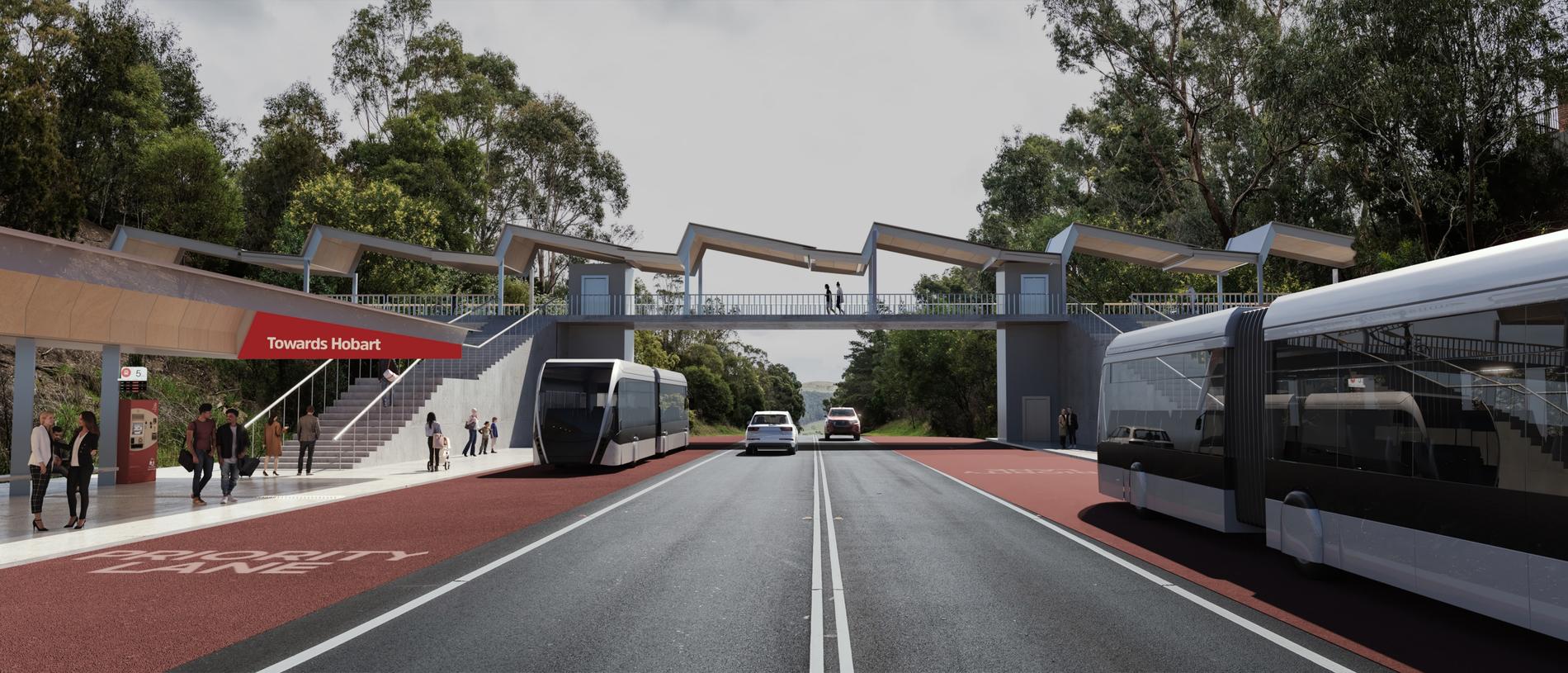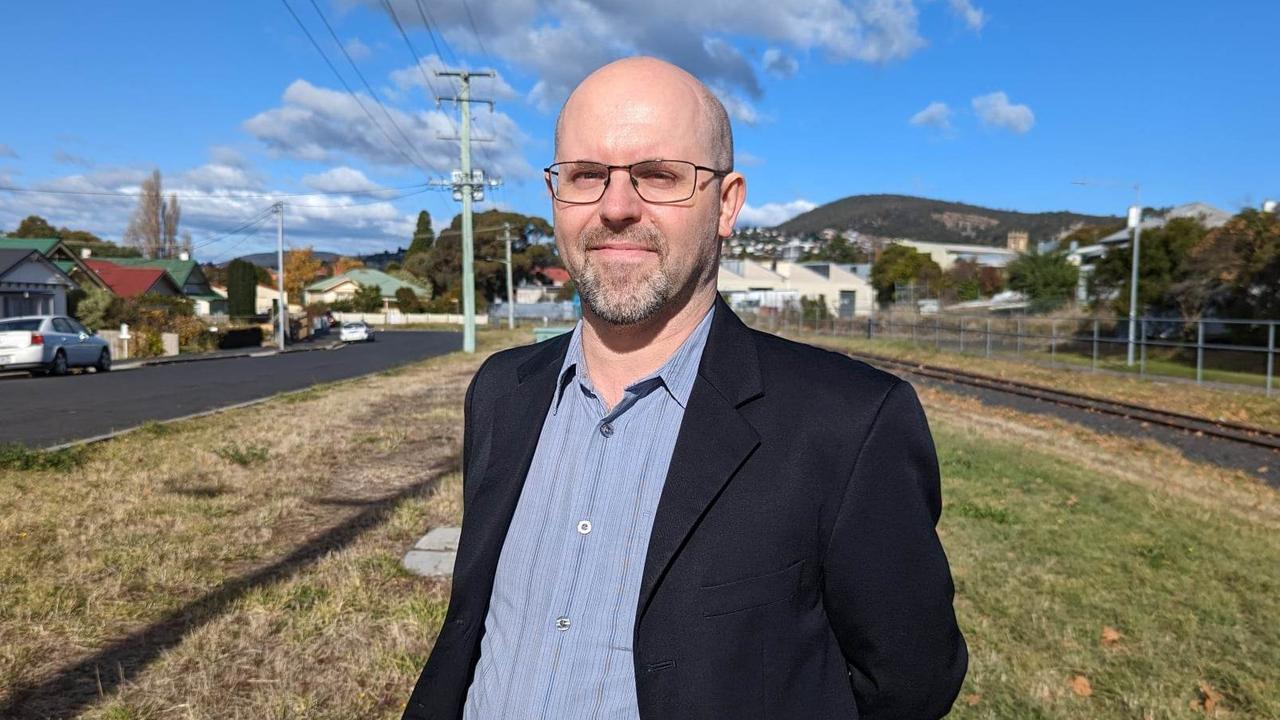Hobart bus rapid transit network: First images of proposed new public transport system unveiled
The bus rapid transit network planned for Greater Hobart has been shrouded in mystery – but concept designs of what the new public transport system may look like have now been revealed.

The first concept images of a new bus rapid transit network planned for Hobart have offered a potential glimpse into the future of public transport in the notoriously car-dependent city.
Artist’s impressions obtained exclusively by the Mercury show sleek, silver rapid buses – with the appearance of trams – moving through Blackmans Bay and the Hobart CBD.
One image depicts a bus rapid transit (BRT) interchange at Franklin Square, while another imagines a ‘pass station’ on Algona Rd near Huntingfield, with red priority lanes for buses.
The images, produced for the Department of State Growth, are a preview of a BRT network proposed for the capital city, which is still in an early planning phase as a strategic business is prepared.
BRT is a high-capacity form of bus-based public transport and typically reserves sections of roads solely for buses. It also usually includes design elements that speed up the transit process for passengers, such as off-board fare collection and priority for buses at intersections.

The network would service Greater Hobart and would operate on the city’s northern, southern, and eastern road corridors, including the Northern Suburbs Transit Corridor (NSTC).
It’s seen as a key pillar of the government’s plans for the Macquarie Point stadium, with the Liberals believing rapid buses can transport people to and from the precinct with frequency and reliability.
Jason Byrne, a professor of human geography and planning at the University of Tasmania, said he believed rapid buses were the best option for the NSTC and that the costs associated with light rail were “prohibitively expensive”, particularly in the wake of the pandemic.
“To give the BRT the best chance to succeed in Hobart, the government will need to commit to the project, to invest in the corridor with high quality stations, to design a system that can meet the peak passenger numbers in morning and evening, and for special events,” he said.

“[It needs to be] safe, convenient, [and] reliable, and provide excellent connections to buses, ferries, and other modes of transport,” he said.
Professor Byrne said BRT would result in “value uplift” along the corridor, which would provide “impetus” for mixed-use development without the “large-scale gentrification effects of light rail”.
However, he added that if there was sufficient patronage and population growth along the NSTC, the BRT network could be converted to light rail “as has been done in Canada”.
Transport Minister Eric Abetz said 2026-29 was an “early estimate” of the initial rollout of BRT services but this was assuming that business cases were “favourable”, funding was “available”, and necessary approvals granted.

“A rapid bus network is more than just a fleet of new buses. Rapid buses depend on a combination of new and existing infrastructure to provide direct and reliable public transport,” he said.
Mr Abetz said costs, designs, routes, and other details relating to the proposal “still need further investigation to ensure the proposal is fit-for-purpose”.
Professor Byrne suggested the rapid buses would need to run every seven-and-a-half minutes during peak hours and about every 15 minutes off peak in order to “meet passenger expectations.
The buses should be able to accommodate large numbers of passengers in comfort, have the capacity to carry about 180 people per vehicle, and move up to 20,000 passengers per hour at peak operating capacity, he said.
A 2020 consultants’ report by PwC found that BRT was the cheapest public transport option for the NSTC, while light rail would be the most expensive. However, the report noted that light rail’s “city-shaping” potential was greater.
The government is also working with the Hobart City Council to plan for a new bus transit centre in the city and is considering how this might interact with BRT services, Mr Abetz said.

Greens transport spokeswoman Helen Burnet is adamant that light rail would be the most effective mode of transport for combating climate change and reducing traffic congestion on the city’s existing road network.
“Hobart is fortunate to have what other cities envy – an existing rail corridor easily reactivated for light rail. Very few changes are required to switch to light rail,” she said.
“Trains have the capacity to adapt to increased needs as required and are predictable – one of the key features for uptake of successful systems.”
Rapid buses would ‘not encourage development’
Hobart Northern Suburbs Rail Action Group president Toby Rowallan said a busway on the NSTC would deliver almost zero additional inner suburban development and would cost more than simply upgrading the existing railway.
He said PwC had estimated that light rail would incentivise the development of four times more new dwellings along the corridor than a bus rapid transit network would.
“In fact, the development generated by the busway on those figures is so bad it’s barely above what might happen if nothing is done with the rail corridor at all,” he said.

“We do not yet know the costing for the busway, except that we are very confident that it will cost more to rip up the tracks and put down concrete than it would cost to simply upgrade the existing rail.”
Mr Rowallan suggested that PwC had “greatly exaggerated” the expected cost of light rail on the corridor in its 2020 transport mode study.
“They have specified standard gauge, which is completely unnecessary and will definitely increase the costs,” he said.
According to Mr Rowallan, using the existing gauge would not require the current line to be torn out and new track to be laid, nor would it necessitate the modification of bridges and culverts or the digging up of level crossings.
“By using the existing gauge, which has never been adequately costed, some – perhaps most – of the track would have to be re-laid, [and] new ballast, et cetera. But none of the other measures … would be required,” he said.
More Coverage
Originally published as Hobart bus rapid transit network: First images of proposed new public transport system unveiled





